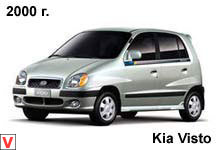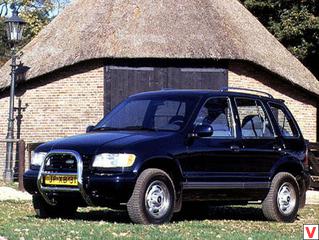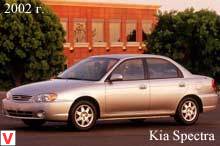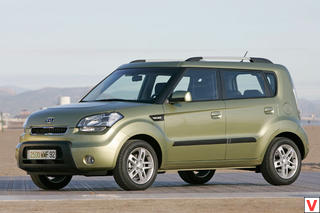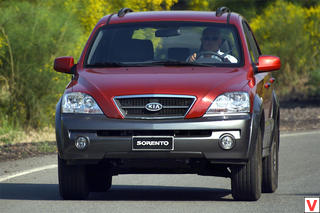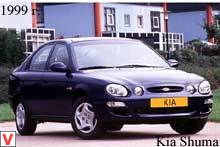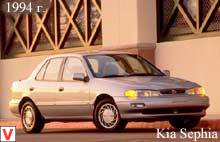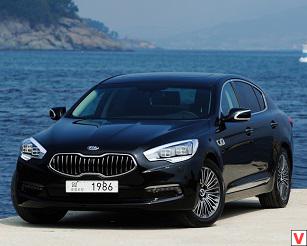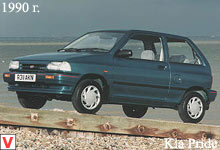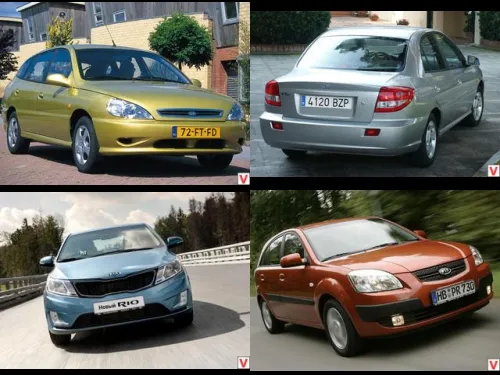
Kia Rio debuted at the Geneva Motor Show in 2000. The car has replaced the discontinued Avella. It belongs to the class B, has a transverse engine, front-wheel drive and is built on the same platform with Sephia / Shuma. The model was produced in three body styles: 4-door sedan, 5-door hatchback and original station wagon, with a rounded rear. Modern design, comfortable interior, roomy trunk, good build quality and reasonable price allowed the car to gain a lot of favorable responses.
The salon welcomes passengers with a cozy interior, but the quality of the materials is low, which, given the cost of the car, is logical. The driver's seat is comfortable, with good lateral support, adjustable in length, angle of inclination and height of the pillow. Ergonomics at a good level, all the controls at hand.
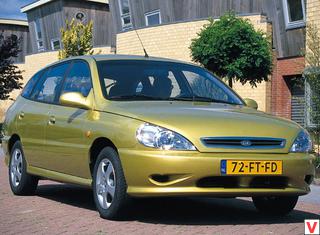
The scales on the dashboard are conveniently arranged - the speedometer takes the central place, and the tachometer is also present. Standard equipment of most of the Rio has power steering, air conditioning, central locking with remote control, airbag, power windows in the front doors, power mirrors, the ability to open the fuel tank flap and trunk from the cabin, stereo. Additional equipment includes: ABS with electronic brake force distribution, front airbags, electric sunroof, CD changer. The range of power units consists of two gasoline engines: a 1.3 liter capacity of 84 hp.
and 1.5 liters capacity of 108 hp There are two gearboxes to choose from: an automatic transmission with 4 speeds and a manual transmission with 5 speeds. The front brakes are disc ventilated, there are drums at the back. In 2003, Kia Rio is subjected to restyling. The model gets an updated design: the headlights have become larger and more expressive.
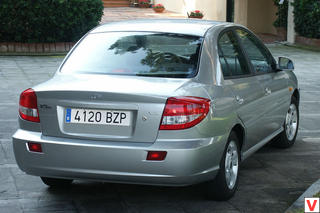
Changed the structure of the body. Improved sound insulation underwent hood, roof and rear shelf. Sound-absorbing material laid trunk, floor, the distance between the dashboard and the engine compartment.
After five years of successful production of Kia Rio, the Koreans decided to release the second generation of this car. Kia Rio II differs completely new, more modern and, in a sense, "European" design of the body, as well as a different interior design. The car got the right, almost classic proportions.
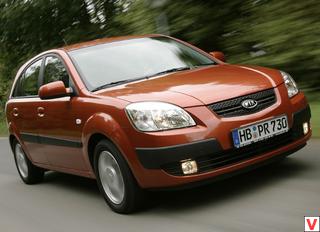
Rio II is built on a completely new platform that will be used not only by Kia, but also by Hyundai. The wheelbase increased from 2410 to 2499 mm. Thanks to the increased base and track, the car has become much more stable on the road and is better controlled. Now, in terms of dimensions, the Rio came as close as possible to the C-Class models: length — 4238 mm (+23 mm), width — 1694 mm (+14 mm), height — 1470 mm (+30 mm). The total volume of the cabin - 2,611 m³. The amount of luggage increased by 29% and reaches 337 liters (+76 liters), besides it can be increased by folding the rear seat backs. External changes affected primarily lighting.
New headlights in a modern, trendy style have visibly refreshed the front end of the Rio. Others have become the front bumper, hood and grille. In general, the appearance of the car seems to have changed slightly, but has become more fit and modern. The interior was much more updated. So, completely redesigned front panel design. Previously, it was clearly limited to the driver's workplace - the center console and the area around the dashboard were made as a single unit and stood out against the general light background with the texture and black color of the plastic.
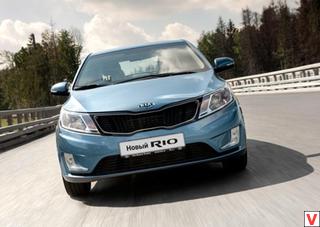
Now, in a similar way, only a part of the center console is highlighted. As a result, the front panel looks more seamless and organic. The instrument cluster is somewhat different in design from the previous one, although it is similar in composition, simplicity and informativeness. Inside it became much more spacious.
This, first of all, was reflected in the rear passengers. The driver's seat, as before, is equipped with a variety of settings, including separate adjustments to the height of the cushion. The salon has expanded, which allowed the manufacturer to make a full-fledged armrest instead of a narrow shelf on the door of the first-generation car and place the control buttons for mirrors and electric lifts on it. The new Rio is still equipped with independent front and semi-rear suspension. In front - McPherson racks checked by time, and behind - torsions. Plus, more front and rear stabilizers. Rio II is offered in two versions - Base and LX.
The basic version (Base) is quite ascetic and includes only 6 airbags, three-point belts, four mechanical adjustments of the driver's seat and heated rear window. In the LX configuration, this list is much richer: power steering and adjustable steering wheel height, air conditioning, audio system with a CD changer and four speakers, folding in the ratio of 60/40 rear seat backrest, full-size "spare wheel". There is also the so-called Power Package, which is available only for LX configuration. It includes electric windows and mirrors, access to the cabin without a key, heated mirrors, two tweeters in the front doors, additional lighting in the cabin and a pocket for sunglasses.
For lovers of the sporty image, a sports package is offered, including a more expensive trim, 15-inch alloy wheels with 195/55 R15 tires, disc brakes on all wheels, fog lights, a rear spoiler, metallized enamel on the body, aluminum pedals, leather-trimmed steering wheel and gearshift lever. Two gasoline engines, designed for the new Kia Rio, added 100 cubes in volume, becoming 1.4-and 1.6-liter (110 hp), respectively. The engines are equipped with a CVVT variable valve timing system. The power unit is combined with either a five-speed manual gearbox or a four-stage automatic, which is put on request.
In addition to size and power, the new Rio has carefully worked on security. Already in the standard, the car has six airbags: two front, two side and two full-size "curtains". Adaptive front airbags - the degree to which they are filled with gas depends on the position of the seat, the speed of the collision and the signal from the seatbelt sensor. The basic passive safety kit includes pretensioners and force limiters for the front seat belts, a 3-point belt for the third rear passenger, and two mounts for child seats. But ABS, rear disc mechanisms and power steering set only for an additional fee. With the new design, Kia Rio has become more attractive for young buyers.
This spacious, comfortable enough and practical car looks modern and European-style. The official presentation of the third-generation Kia Rio was held March 1, 2011 - the opening day of the Geneva Motor Show. It is noteworthy that in the Korean, European and American markets a slightly different version of Rio is sold. The Kia Rio for Russia was based on a version for the Chinese market - the Kia K2 - and adapted for Russian conditions. The Rio sedan for the Russian market has been produced since August 2011 in St. Petersburg, production of hatchbacks started a little later in early 2012.
At the heart of the car is a front wheel drive platform, on which Solaris is based, and which also serves as the basis for the Hyundai i20 hatchback. Front McPherson strut with transverse stabilizer, rear - longitudinal levers. For better controllability, the steering mechanism is equipped with an electric booster, and to increase the level of safety, all brakes have ABS and ESP disc brakes. The appearance of the third Kia Rio is strikingly different from previous generations, and this is a great merit of Peter Schreier, the former director of Volkswagen Design.
Sports dynamic mood sets the wedge-shaped front of the car, the continuation of the idea is noticeable in the athletic vyshtampovki sidewalls, and the final stroke is outlined in the taut stern. Another important difference of the updated Kia Rio is its increased size, the wheelbase has increased by as much as 70 mm, which has a positive effect on the cabin space. Ground clearance - 160 mm.
Inside it became more spacious and comfortable. The driver's seat is quite comfortable, thanks to the adjustment of the seat and steering column. Unfortunately, the wheel can be adjusted only in height (in the range of 40 mm), but not on the departure. The dashboard is quite informative and different horizontal architecture. Everything you need to manage auxiliary systems at hand. Finishing materials have become more expensive, optionally available two-color panels.
The trunk has become wider, and its useful volume has increased to 500 liters, while the folding back of the back sofa in the ratio of 60/40 allows you to carry oversized cargo. The third generation Rio on the Russian market is equipped with two petrol “fours” of the Gamma series - with a volume of 1.4 liters (107 hp, 135 N • m) and 1.6 liters (123 hp and 155 N • m). The most powerful engine can accelerate a car up to a hundred in 10.3 seconds, and a 1.4-liter has a moderate “appetite” of about 6.0 liters per hundred. The cylinder block of both engines is aluminum, as is the upper part of the crankcase. The gas distribution mechanism with the inlet phase shifter is driven by a chain.
The power supply system with distributed injection is adapted for use on AI-92 gasoline and is designed for cold starting at —35 ° C. The engines are aggregated with a five-band “manual” gearbox or a four-stage “automatic”. Europeans are available of course more. U2 turbo diesel engines and ISG eco-friendly technology are available for them. The car is available in four trim levels (Comfort, Luxe, Prestige and Premium), while the list of available options is extensive, there is a Russified on-board computer, heated mirrors and a windshield, leather steering wheel, gearshift lever and dashboard, as well as other pleasant and useful stuff.
Basic equipment Comfort offers: two airbags, ABS, air conditioning, front electric windows. Luxe package will please CD / MP3-audio system, rear electric windows, heated front seats and fog lights. Prestige version: side airbags and curtain airbags, climate control, leather-wrapped steering wheel and gear lever, light-alloy wheels. The five-year warranty for Rio (or 150 thousand km) applies to the engine and gearbox.
